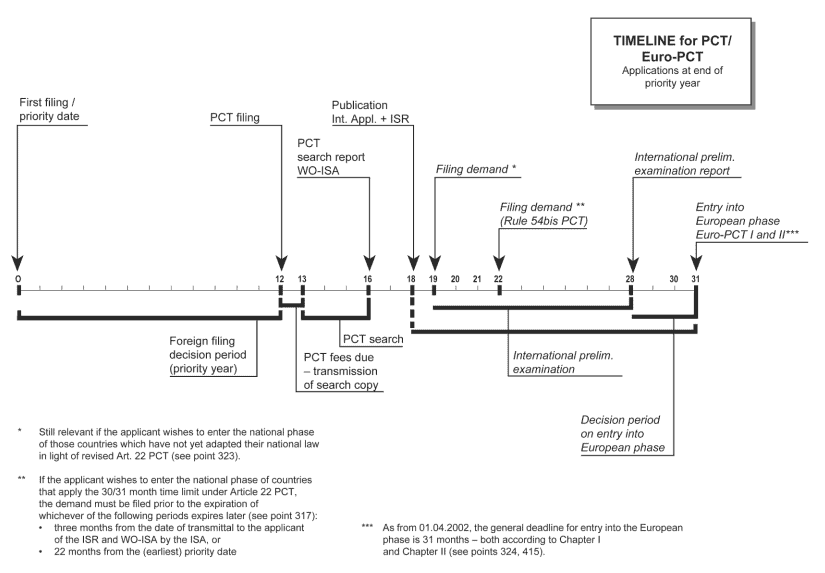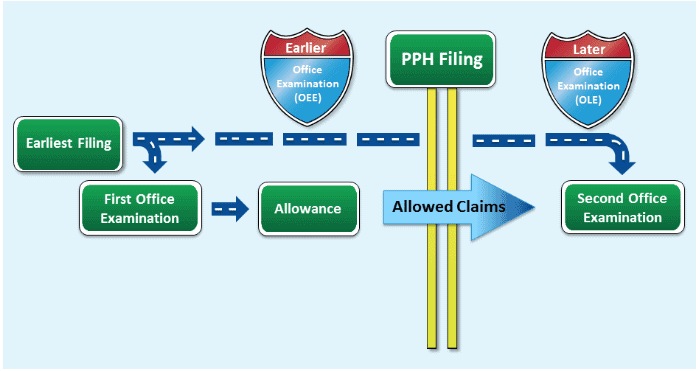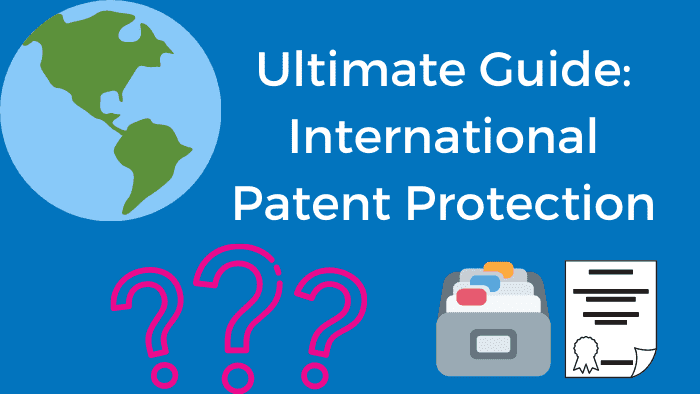Ultimate Guide: International Patent Protection
National market dominance not enough for you? Well… this is the article for you!
If your invention is likely to have market adoption/demand outside of the US, then you should certainly read on. This article will outline the ins and outs of the international patent filing process, as well as the multinational application process (the Patent Cooperation Treaty (PCT)) and the European Patent Convention (EPC).
How do I get international patent rights?
Unfortunately, there is no such thing as “international patent rights”.
If you want patent rights in multiple countries, you’ve got to apply for patent protection in each country you want protection… I know, kind of a lot of work, right?
The upside is that there are a couple of great tools out there (PCT patent, EPC patent, etc.) that will enable you to save time and money in filing in multiple countries.
The other nice thing about patent laws across the world is that the high-level concept is the same no matter where you go. An exclusive right is granted to an inventor for a limited amount of time in order to incentivize/reward them for sharing their invention with the public.
Here are the topics that I’m going to cover to help you understand international patent applications:
- Calculating the benefits vs. costs of international/foreign protection
- Understanding the PCT, EPC and other frameworks
- Relationship between US patent filing and International/Foreign Application
Benefits vs. Costs of International Patent Protection
Aside from there being a true market potential in these other foreign markets, it is important to weigh the costs and benefits of pursuing patent protection overseas upfront.
Generally, if you thought the costs of obtaining and enforcing patent rights in the US were high, foreign costs could easily be double due to the variability with each country’s system (prosecution, grant, and maintenance). Furthermore, there is the need to rely on translations, more service professionals, and overall unfamiliarity with the patent office and court systems/processes.
It should be well-noted that there is no such thing as a singular “international patent application” or “global patent”. You must seek an application in each country. There are many things you can do to make the work of applying in each country (called the national phase) much easier.
As will be discussed in this article, the Patent Cooperation Treaty (PCT) is the best way to save money and streamline the entire
Here are the factors that should be considered when deciding whether to file for international patent protection:
Enforceability
Even if you get patent rights in the foreign market, is the country’s patent system reliable and equitable?
This should be the first consideration. You can rely on your patent attorney for some insight, but you’ll want to bend the ear of a foreign counsel to ask about the process for enforcement of patent rights, as this will have a lot of pull in terms of the value of the foreign patent asset for license/sale/enforcement.
Deep Pockets
Do you (or your company) have the resources to afford heightened foreign associate fees, translation costs, prosecution costs, and annuity/maintenance fees?
If you are seeking rights overseas, you’ve got to have very deep pockets (or deep-pocketed investors) that are willing to fork over added fees to acquire foreign rights and even more to hire foreign counsel to enforce them.
Helpful Article:
- Blog Article: How to Find Funding and Grants for Patents
Invention Eligibility
Have you confirmed that the foreign countries sought will uphold the invention as eligible under their rules/provisions?
Not all countries allow as broad of protection for innovation in areas such as healthcare therapies/diagnostics/gene expression. It will be important to confirm this prior to investing money in seeking patent protection in a more restrictive jurisdiction.
Helpful Article:
- Blog Article: Is my Patent Eligible?
Technology Longevity
Is it a “fad” type of invention? Or long-lasting?
If your invention is more of a consumer product that will likely be eclipsed by the next big thing in 3-4 years, it is likely not worth the expense of filing in foreign countries, even if there is going to be a market success there. A market study will be important to make a final decision.
Licensability
Are there opportunities to patent license or sell the invention to other businesses in the foreign jurisdiction?
If your plans are flexible, and you’re open to partnering with affiliate companies to make/use/sell your invention overseas, you can seek partners who may wish to pay a royalty for the benefit to make/use/sell your invention. This can be a very low-cost way of playing on a global scale, without having the sole cost/risk associated with enforcement.
Note that with exclusive licensees, there is a burden to help the patent owner litigate/enforce in most cases – meaning the licensee would be required to help with litigation/enforcement against any infringers.
Supply-Chain
Would your invention likely be manufactured, distributed, and sold in the foreign jurisdiction?
If so, these are countries worth looking into seeking rights in, as they are countries that are most susceptible to patent infringement.
If the country was going to be the country you were going to manufacture in any way (even if your patent was only in the US), you should seek protection in that country so that you can control who may manufacture/import/sell out of that country.
Competition
Do you have competitors in the foreign jurisdiction?
This question is a great way to think about potential infringers and to seek patent protection where they might be. It is also a good indicator for where your market may be – if there are competing companies, then there will likely be people interested in buying that type of product/solution.
Costs of International Patents
Are you prepared to shoulder the costs of applying for international patents?
This is an important question to ask yourself as you weigh your options. If one were to try to obtain patent protection in every country around the world, the estimated cost would be upwards of $2 million. Fortunately, obtaining international patent rights in several countries is not quite that cost prohibitive when PCT or EPC filings are an option. You can expect to pay between $3,000 and $4,500 for a PCT application, including government fees, attorney fees, translation costs, and maintenance fees. In addition, transmittal, search, and international fees can add approximately $3,600 to the total. Ultimately, the cost of obtaining an international patent depends largely on the nature and complexity of the invention and the size of your business.
Do you want to learn more? Book a free consultation with us!
How do Applications for International Patents Work?
The framework is really important to understand, and I’ll walk you through it. But, if you only remember one thing, the KEY is to know that its ALL about priority. In other words, you get the benefit of having the early invention filing date from the U.S. patent filing (usually a provisional patent application). This way, any inventor that files after that date (in the world) will be out of luck, and you’ll win in a priority battle.
The second most important thing to come away knowing is the 1-year priority date rule. This means that a foreign patent filing can only claim priority back 1 year (12-months). So, whether its a provisional or a non-provisional that was your first filing, you only have 12 months after that date to file a foreign patent application.
In many cases, what will be recommended is a PCT patent filing or EPC filing. These give you more time (up to 18 months) to decide which countries you want to enter into.
Understanding the Patent Cooperation Treaty (PCT)
The PCT has been signed by virtually every country with a patent system (except Taiwan, Hong Kong, and some South American countries like Argentina – although they have separate convention agreements in place).
PCT Timeline
The PCT gives the applicant the right to file a national-stage foreign patent application for up to 30 months (some countries allow up to 31 months) after the U.S. priority date. This means that by simply filing the PCT application (international application) you are buying an additional 18 months of time to decide which countries (if any) you wish to file into.
Most inventors around the world will designate a US-based examiner to be the International Search Authority (ISA) who will conduct an international search and be the basis for all country’s later examination.
The USPTO is sought after for searching as they are seen as the best and most sophisticated… although it comes at the highest cost. The lowest cost country is Russia, however the search results are sometimes suspect, and may be called into question by subsequent countries.

The chart above lays out the PCT system. The important things to see in the chart are the timeline (which shows months) and that from the priority date in the US (month 0), you have 30 months to select which countries you want to seek protection in.
At Bold Patents, we suggest filing an EPC application at the 30-month mark, which allows for even more time to select which European countries (if any) would be sought after for protection. A major boon to waiting is to see if there is the commercial success of the invention/solution in the subject international markets.
Understanding the European Patent Convention (EPC)
The EPC is a European-only filing, which is like a mini-PCT in many ways but only for Europe. The treaty has been signed by all notable/important European countries.
The European Patent Office (EPO) is based in Munich, Germany, and examines patent applications in English, French, or German. This examination is what differentiates the EPC and the PCT – with the PCT, there is no examination, only searching, so the applicant must elect the national phase country (within 30 months of the priority date) and then examination in that country takes place.
On the other hand, the EPC applications get searched and examined on behalf of all European countries and the only decision (assuming the patent is granted by the EPO) will be whether to pay the fees to get the patent rights in specific countries that are a part of the EPC.
The EPO website is quite useful, and they provide a great summary of the process. Below is a flowchart that shows the PCT and EPC applications combined:
The Relationship between US Patent Application and Foreign/International Application
As an invention gets fleshed out and more details are evident, the rule is to make sure that every embodiment and version of an invention is fully discussed, enabled, and eventually claimed in the application.
This rule helps US inventors get the biggest scope of rights possible. The only potential issue is that as part of this invention expansion process, the specifications (written descriptions) tend to get quite large.
The size of the specifications doesn’t really matter too much at the US phase, but in the international phase, it matters a lot. Added pages for specification can mean thousands of extra dollars in fees for going over standard page allotments. So, there is a need to modify/compress/reduce the specification when filing overseas to avoid paying huge fees.
You do need a foreign filing license in order to file internationally. This is usually not a big deal for most applicants, as the USPTO issues the licenses routinely when you send in an application. The only potential problem that could arise is if a national security threat is identified under 35 U.S.C. 181.
A very cool program called the Patent Prosecution Highway (PPH) has been instituted which will allow any patent that has been granted by the USPTO to be fast-tracked through search/examination by a foreign patent office. The flowchart for the PPH program is shown below:

In Summary
To recap our international patent discussion here is what we covered:
Table of Contents
- Benefits vs. Costs of International Patent Protection
- How do International Patent Applications Work?
- The Relationship between US Patent Application and Foreign/International Application
So, do you feel ready to tackle the global marketplace? I’m sure it’s ready for you!
Hopefully, this guide helped to provide the most important basics about international patent law and how to protect your invention overseas so that you have a good idea of where to start!
The most important things to remember when considering an international patent application are:
- Weighing the benefits vs. the costs
- Knowing how they work
- Understanding the relationship between the U.S. patent application and foreign applications
And now you’re ready to go! Do you think your invention would benefit from an international patent application? Which countries are you ready to take on?
Make sure to read our other relevant articles:
- Blog Article: How to Patent an Idea
- Blog Article: How Much Does a Patent Cost
Book a free consultation with us to discuss more!
Legal Note: This blog article does not constitute legal advice. Although the article was written by a licensed USPTO patent attorney there are many factors and complexities that come into patenting an idea. We recommend you consult a lawyer if you want legal advice for your particular situation. No attorney-client or confidential relationship exists by simply reading and applying the steps stated in this blog article.

